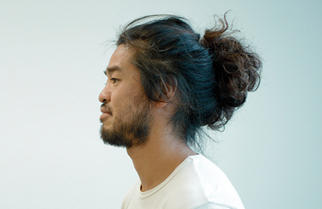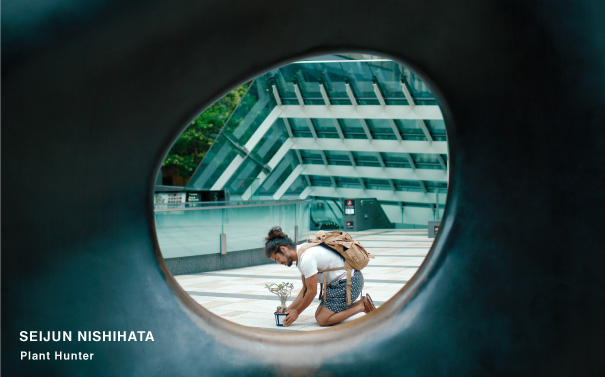
72 Seijun Nishihata(Plant Hunter)

Seijun Nishihata, a plant hunter and owner of Sora Botanical Garden, has been involved in numerous greenery projects around the world. His mission, he says, is to make people more aware about plants and the natural environment. For Roppongi Art Night 2016, Nishihata and sculptor Kohei Nawa created a temporary "forest" to symbolize the "dawning of culture" in Roppongi. In this interview, he talked about his thoughts on greenery and the future.
The greenery was here first
I've been told that the topics of this interview will be Roppongi, the future and greenery. If you ask me, greenery is the future. Put very simply, thinking about plants and greenery is basically the same as thinking about our future.
It's often said that you can foresee the future by looking at the past. 450 million years ago, when plants began covering the earth, there was no culture or religion or art on this planet. So in a sense, plants are the foundation of everything. I think that the more we pursue the latest technology, the more we need to go back to basics in order to know what is really important. Companies that are sensitive to trends and people such as creators and artists who influence society are beginning to realize this. We are at a moment when many people are becoming aware of the importance of the natural environment.
I'm from the Kansai region, so I don't know Tokyo that well, but I do feel that Roppongi is a place reflecting the latest trends. If Roppongi is going to aim to become an outstanding place in Tokyo, in Japan, or in the world, it needs to take the lead in the area of plants and greenery as well.
Making people aware of the trees
If you were to ask people in the streets about the greenery in Roppongi, I think most people would agree that there are many trees. But if you were to ask "What kind of trees are there in Tokyo Midtown?" or "What are the names of the trees in that boulevard over there?" they probably would say, "Eh, I'm not sure."
People know so much about architecture designed by famous architects or about bakeries that sells tasty bread, but they don't know what kind of trees are in the neighborhoods where they live. And most of the companies that are involved in CSR (corporate social responsibility) activities place importance on the number of trees they've planted. They declare, "We planted so and so many trees in such and such place."
But there must be better ways to touch people's hearts. Instead of focusing on numbers, the focus should be on quality and the messages given out. For example, rather than trying to triple the number of trees planted in Roppongi, it's better to make people aware that there are trees here. If you could communicate this in Roppongi, I think things will change.
The importance of presentation
The project for Yoyogi Village which I was involved in, is a good example that provides hints. The theme at Yoyogi Village is "co-existence" and plants from all over the world are growing there together side by side.
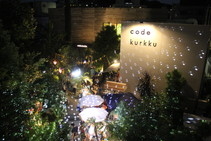
Yoyogi Village
A commercial facility in Tokyo's Shibuya ward. Its concept was conceived by musicians Takeshi Kobayashi and Shinichi Osawa and its interior was designed by interior designer Masamichi Katayama. It has a garden filled with plants from around the world including a large 500-year-old olive tree, a flower that blooms every 100 years and a prickly cactus said to be the "most painful" in the world.
Gardeners and landscape designers tend to be keen on design and in coordinating plants, but the really important thing is the concept. For Yoyogi Village, I tried to think outside the box, and I chose plants that would not usually be placed together. Beside a tree from China, there's a tree from Peru, and beside that are trees from Argentina and Australia. The sight could be worrisome for people and they might think, "Is it okay to put them together like this?" Making people ponder such a question is one way of raising awareness.
And on the profile plates placed on the trees, I wrote down my own mutterings instead of the difficult names of order, genus and species. People found them very interesting and I actually got requests from several local governments for the same kind of plates to be used on roadside trees. With the right presentation, you can turn an ordinary elm into an interesting elm.

Lack of variety in Japanese street trees
It's only natural for people to want trees in the streets. Before humans built all these buildings, we were surrounded by greenery. Right now as we sit here in Tokyo Midtown, I can see many kinds of trees in the garden - Somei-yoshino, Japanese zelkova and over there, a Himalayan cedar. There are plane trees, camphor laurel, ginkgo, and coast redwood - the tallest tree in the world - as well as momiji (Japanese maple) and willow trees.
It's good that there are many kinds of trees. In Japan, the trees that you see in towns are those that have been procured from the mainstream market. There's no law that says roadside trees have to be a certain way. There ought to be more variety and we should have trees that are bent or very old.
In other countries, there are trees that are hundreds of years old standing in the streets. But people in Japan don't know that and they keep on planting trees distributed in the mainstream market. It's impossible for people to tell the difference between the trees in Roppongi from those in Daikanayama because essentially, it's as if the same colors from the same palette are being used.
A boulevard where each tree is different
When I was advisor for the greenery at the complex facility Park City Osaki, I took a very different approach. I suggested lining the boulevard with trees that were all different - every one of them.
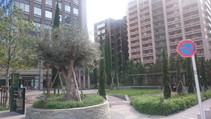
Park City Osaki
A large-scale shopping and residential complex in Tokyo's Shinagawa ward which was completed in 2015. Consisting of 7 buildings and seven gardens, it is situated on 3.6 hectares of land, 30% of which is greenery. The streets are lined with seven types of trees such as asunaro (hiba arborvitae), kusu (camphor laurel) and shirakashi (quercus myrsinifolia). At the intersection there are Shidare-zakura (drooping cherry) trees as well as an olive tree which is the symbol tree for this area.
The concept for the facility is "organic city." I could talk about this until tomorrow night, but I will try to explain simply. (laughs) When you say "organic" people think of chemical-free vegetables, but the word was initially used to describe the way different elements come together to make a single structure.
The plan for Park City Osaki was to build a town consisting of commercial facilities, housing, offices, places for entertainment and parks. A town made up from different elements - a town like a living organism. So I wondered if we could develop an organic town that is like a living organism and which is also "organic" in the sense that one can feel close to nature. In a town that is meant to be eco-conscious, it's so unnatural to see the same type of trees in a row, all cut to stand at the same height. I'm not a landscape designer or gardener, but since I was participating in this project as an expert on plants, I wanted to express the concept of "organic" through every tree.
Editor's note:The GENIUS English-Japanese dictionary defines the English word "organic" as below:
【or・gan・ic】
1.Organic being, living organism (or something derived from an organic being)
2.Organic structures or systems
3.a. Organ of a plant or animal b. deriving from the organs
4.Mild or natural change or development
5.Fundamental, essential, distinctive, structural, basic.
The Kojien Dictionary defines "yuki" (organic), "yukitai" (organic body) and yukiteki (organic) as below:
【Yuki】
Having life
【Yukitai】
1.Substance system that is structured to have a living function
2.Something that is made up of many different parts that are integrated to serve a certain purpose, with each part and the whole corresponding with each other. Analogous to "natural" and is also used to describe social phenomena.
【Yukiteki】
The state of something made up of many different parts which are integrated and closely connected to each other, with the parts and the whole having a corresponding relationship.
A message that people will eventually receive
At first, of course, there was opposition to my idea because it was unprecedented. But I explained in detail about the various ways that trees are planted in streets overseas, and people became interested in realizing the idea. They had initially been saying "One type of tree is sufficient" but they changed their minds - their brains gradually became more organic. (laughs)
The Champs-Élysées in Paris is a boulevard with neatly trimmed plane trees, but at the back is the Avenue Foch - a boulevard that is like a garden, with all kinds of trees planted at random intervals. It's a place where grandmas and grandpas enjoy taking walks.
The trees I plant will remain long after I'm gone. The decisions made at a meeting will have an effect on the environment 100 years from now, so I have to be responsible. The life span of a landscape is longer than that of architecture. The trees and plants have just been planted, so people may not understand right now, but 10 or 20 years later, the flowers will bloom at a totally unexpected time. And it's my hope that people will eventually get my message - perhaps after my death.

Portland and Singapore - countries with remarkable greenery
From the perspective of greenery in towns, I think Portland is a country we should pay attention to. In Japan, the branches are cut really short because they don't want people complaining about falling leaves, but in Portland, the trees are allowed to grow so that the branches extend across the street over to the nearby park. What a refreshing sight that is.
The way the trees are pruned in Japan probably won't change until there is a collapse in the current system of having designated companies carry out routine maintenance work. Because Tokyo will host the Olympic and Paralympic Games, there are now apparently plans to refrain from pruning the roadside trees as much as possible so that shade can be created. That's tantamount to admitting that the way they usually prune trees is wrong. Many people suffer from heatstroke each year. It would make such a difference if greenery was allowed to shade the streets.
The job of a plant hunter
Another country we can learn from is Singapore. Its founding father Lee Kuan Yew decided that he would make Singapore a country of greenery and even though the country had just become independent and didn't have money, Lee planted plants collected from all over the world. Singapore became lush with greenery and came to be called the Garden City; apparently the greenery really is helping to lower the temperature. It seems that nobody at that time could keep up with Lee; he was a person with foresight.
In Singapore, the branches of trees that have grown too long are turned into biomass and used as energy for the air conditioning at a huge botanical garden called "Gardens by the Bay." This year marks the 50th anniversary of diplomatic relations between Singapore and Japan, and I was asked to do a flower event - something that the government had long wanted to do. So we arranged for a great number of sakura cherry blossom trees all over Japan to be shipped to Singapore. The trees bloomed there wonderfully and an unbelievable number of people came to visit. I heard that even Prime Minister Lee Hsien Loong dropped by.

Blossom Beats
An event themed on Japanese spring flowers that was held in Singapore in March 2016. In the huge Flower Dome greenhouse at Gardens by the Bay, more than 20 types of flowers and trees including sakura cherry blossoms and peach trees were displayed. Amid worldwide reports on the event, as many as 20,000 people visited during just one weekend.
If it weren't for that event, those sakura trees would not have been appreciated by anyone; there are so many trees in the world that remain unappreciated. The job of the plant hunter is to bring trees that would otherwise remain obscure to the people who are waiting to see them. What makes the job of the plant hunter worthwhile is seeing how it benefits the farmers, pleases the clients and delights the visitors.
Collaborating with artists
For Roppongi Art Night 2016, I was given the opportunity to collaborate on an installation with Kohei Nawa-san. I was asked to cooperate on a project involving plants, and as with any request I receive, I wanted to do my best. At first, I was asked if I could bring blooming sakura trees to Roppongi in the autumn, but as we talked, we decided to make an installation based on a story of deer traveling around the world and reaching Roppongi.
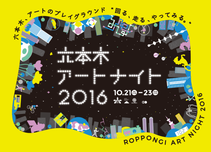
Roppongi Art Night 2016
Held Oct. 21 (Fri) ~23 (Sun) 2016. Nishihata, together with Nawa Kohei, and the creative duo Daisy Balloon which makes balloon creations, collaborated in making "forests" in three areas - Roppongi Hills Arena, Tokyo Midtown and the National Art Center, Tokyo. The forests symbolized the "dawning of culture" in Roppongi.
In a forest made up of greenery from all over world, the symbolic "Ether" sculptures and deer suddenly appear. Setting up a forest for a two-day event is a big project but decisions were quickly made by just the two of us sending each other a few messages by cell phone.
Being a plant seller, it's my job to deliver plants to clients, but at the same time, I want to take advantage of opportunities to make people aware of how wonderful plants are. I think art is very effective in making people recognize the appeal of plants. I didn't know anything about art, but at age 35, I've finally come to think that art is interesting.
An "organic" Tokyo 2020 Olympics
The other day, I was watching the opening ceremony of the Rio Olympics; alongside the delegations of athletes bearing flags, there were people carrying potted plants. It was an astonishing, breathtaking sight for me. There was a performance where the athletes planted seeds in the pots, and greenery was installed to make up the five Olympic rings. It was fantastic how they told the story.
I hope that at the Tokyo Olympics in 2020, we could develop on that story. Perhaps we could show how the seeds that have been planted have grown in the period of four years. We could send the message that the Olympic Games will aim to be environment-friendly. I hope it will be an organic Olympics of a kind that has never been seen before. I'm sure it would resonate with everyone.
Taking action for the future of Roppongi
If we don't act now, Tokyo and Roppongi will stay unchanged. I can see how things will stay the same 10 years or 20 years later if we didn't take action. But surely, we want the world to be a much better place 10 or 20 years later, or after we die. So now is the time to think about what the steps to be taken.
With money, you can buy all the plants you want, but the important thing is to make the most of what we have now and to present them in the right way. At Yoyogi Village, the initial plan was to plant trees bought from the mainstream market, but Takeshi Kobayashi-san who was supervising the project said, "If we do that, we will end up with the same kind of commercial complex we see everywhere." And he said to me, "Please implement your ideas to your heart's content."
I said "Even under the same conditions, I will bring greenery to this place that will have three times more value". Yoyogi Village is a small facility and yet now it draws tens of thousands of visitors every month. All kinds of people from the construction industry come to take a look. Many commercial complexes with a lot of greenery have been built one after another. The stance until then was to plant trees because of the greenery ordinance. Greenery was like an afterthought, but I think people realized that a branding strategy based on plants becomes a magnet that draws visitors.
Planting six forests in Roppongi
I hope Roppongi will also send a message through its street trees and shrubs.
It would be nice if discussions could be held between people who are earnest about improving the streets, or if plant-lovers like me who are trying to expand their activities could be given a chance to talk. Perhaps you could have a conference or a sort of garden party to discuss the future of greenery in Roppongi; you could gather all kinds of people - experts in various genres, the general public as well as people in powerful positions. When you hold talks under a big tree, you can come up with very good ideas. It's no good talking in a conference room, wearing severe expressions.
Oh yes, and one more thing. Roppongi means six trees, so how about making forests based on six concepts where artists can display outdoor artwork? If you are serious about this, I can come up with plenty of other ideas. When it comes to plants, there is no end to the stream of ideas that come to me. But maybe I will have to charge a fee. (laughs)
Editor's comments
Nishihata-san had an appointment after the interview but he seemed to be in no hurry.
"Let's keep on talking until the last minute," he said. "It would be great if we could realize all these ideas!" The photos for the interview were taken in front of a public artwork at Tokyo Midtown - a place where artworks will be displayed during Roppongi Art Night. We hope you will come to the event and view them.
(edit_kentaro inoue)




